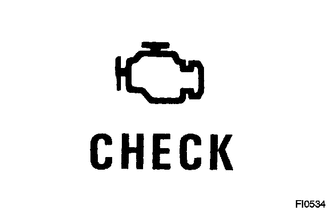DIAGNOSIS SYSTEM 1. DESCRIPTION
- When troubleshooting OBD II (On-Board Diagnostics) vehicles, the
Techstream (complying with SAE J1978) must be connected to the DLC3
(Data Link Connector 3) of the vehicle. Various data in the vehicle's
ECM (Engine Control Module) can then be read.
- OBD II regulations require that the vehicle's on-board computer
illuminate the MIL (Malfunction Indicator Lamp) on the instrument panel
when the computer detects a malfunction in:

- The emission control systems components.
- The powertrain control components (which affect vehicle emissions).
- The computer itself.
- In addition, the applicable DTCs prescribed by SAE J2012 are recorded in
the ECM memory. If the malfunction does not recur in 3 consecutive
trips, the MIL turns off automatically but the DTCs remain recorded in
the ECM memory.
- To check the DTCs, connect the Techstream to the DLC3. The Techstream
displays DTCs, freeze frame data, and a variety of engine data. The DTCs
and freeze frame data can be cleared with the Techstream. In order to
enhance OBD function on vehicles and develop the Off-Board diagnosis
system, Controller Area Network (CAN) communication is used in this
system. CAN is a network which uses a pair of data transmission lines
spanning multiple computers and sensors. It allows for high speed
communications between the systems and simplification of the wire
harness connections.
2. NORMAL MODE AND CHECK MODE The
diagnosis system operates in normal mode during normal vehicle use. In
normal mode, 2 trip detection logic is used to ensure accurate detection
of malfunctions. Check mode is also available as an option for
technicians. In check mode, 1 trip detection logic is used when
simulating malfunction symptoms for increasing the system's ability to
detect malfunctions, including intermittent problems (Techstream only). 3. 2 TRIP DETECTION LOGIC
- When a malfunction is first detected, the malfunction is temporarily
stored in the ECM memory (1st trip). If the same malfunction is detected
during the next subsequent drive cycle, the MIL is illuminated (2nd
trip).
4. FREEZE FRAME DATA
- The ECM records vehicle and driving condition information as freeze
frame data the moment a DTC is stored. When troubleshooting, freeze
frame data can be helpful in determining whether the vehicle was moving
or stationary, whether the engine was warmed up or not, whether the
air-fuel ratio was lean or rich, as well as other data recorded at the
time of a malfunction.
5. DLC3 (Data Link Connector 3) Check the DLC3 (See page
 ). ). 6. BATTERY VOLTAGE Standard voltage:
11 to 14 V
- If voltage is below 11 V, replace or recharge the battery before proceeding.
7. MIL (Malfunction Indicator Lamp) (a) The MIL is illuminated when the ignition switch is first turned ON (the engine is not running).
(b)
The MIL should turn OFF when the engine is started. If the MIL remains
illuminated, the diagnosis system has detected a malfunction or
abnormality in the system. HINT: If the MIL is not illuminated when the ignition switch is first turned ON, check the MIL circuit (See page
  ). ). 8. ALL READINESS
HINT:
- With "ALL READINESS", you can check whether or not the DTC judgment has been completed by using the Techstream.
- Check "ALL READINESS" after simulating malfunction symptoms or for validation after finishing repairs.
(a) Connect the Techstream to the DLC3. (b) Turn the ignition switch to ON.
(c) Turn the Techstream on. (d) Clear the DTCs. (e) Turn the ignition switch off and wait for at least 30 seconds.
(f) Turn the ignition switch to ON and turn the Techstream on. (g) Perform the DTC judgment driving pattern to run the DTC judgment.
(h) Enter the following menus: Powertrain / Engine and ECT / Utility / All Readiness.
(i) Input the DTCs to be confirmed. (j) Check the DTC judgment result. Techstream |
Tester Display | Description | |
NORMAL |
- DTC judgment completed
- System normal
| | ABNORMAL |
- DTC judgment completed
- System abnormal
| | INCOMPLETE |
- DTC judgment not completed
- Perform driving pattern after confirming DTC enabling conditions
| | N/A |
- Unable to perform DTC judgment
- Number of DTCs which do not fulfill DTC preconditions has reached ECU's memory limit
| |